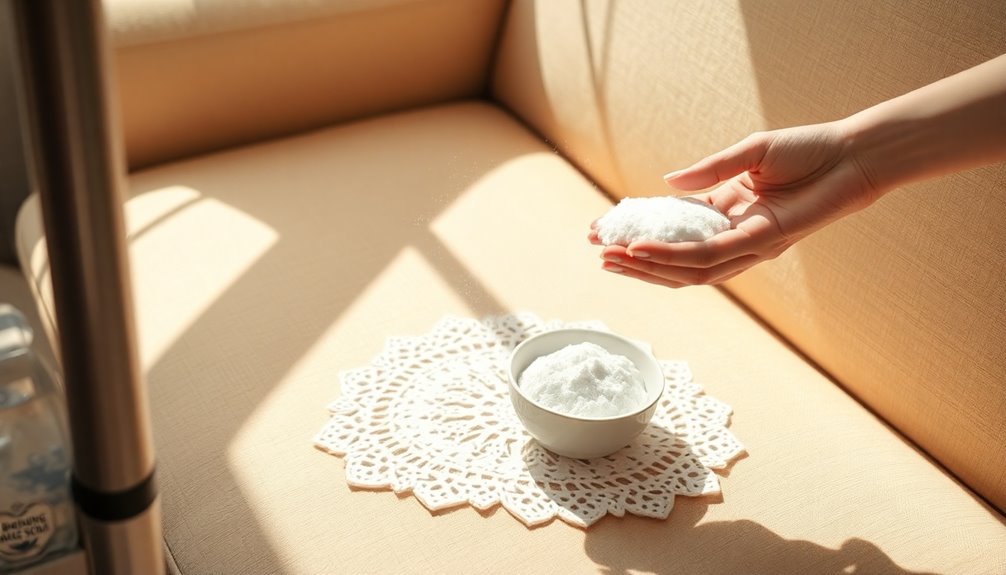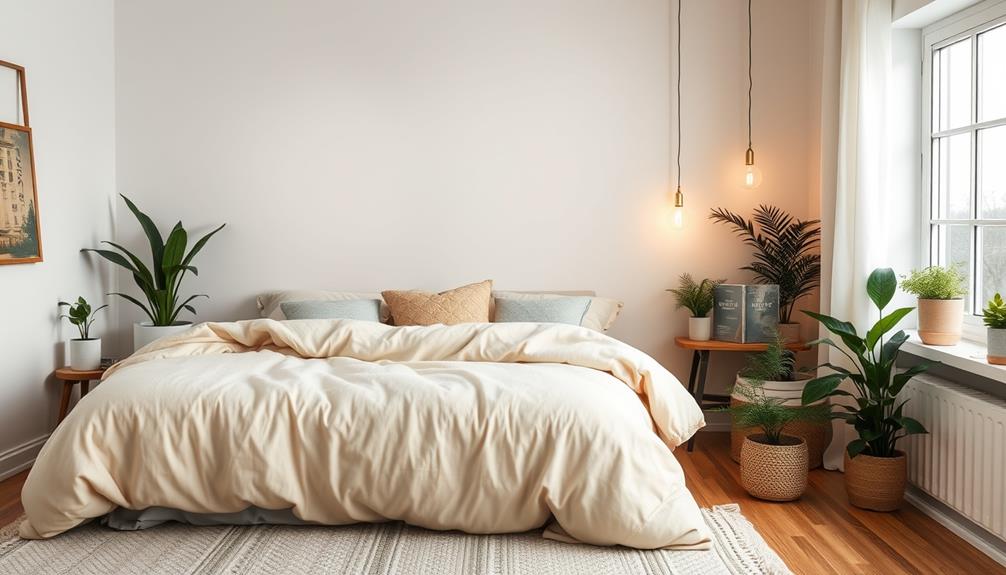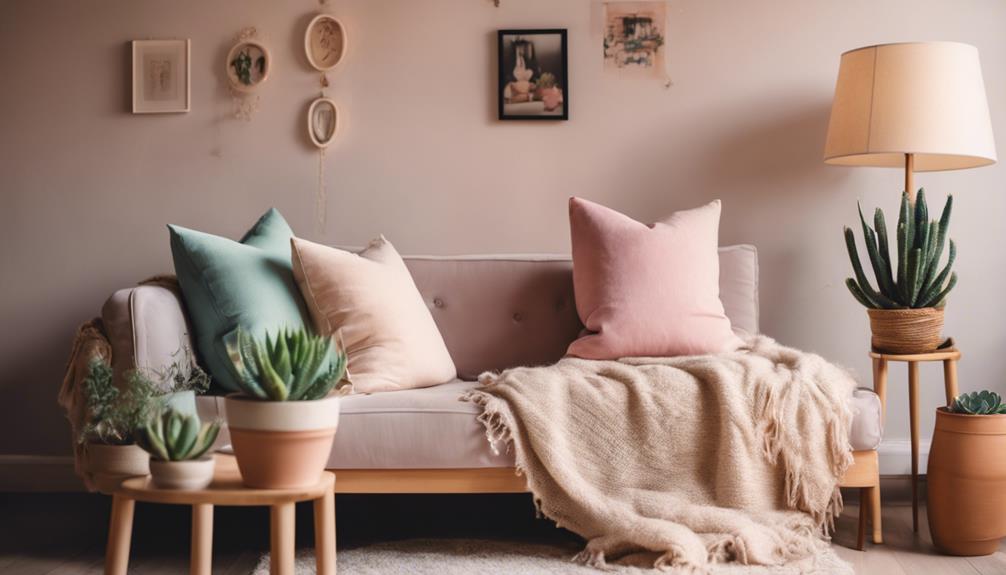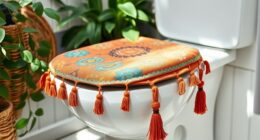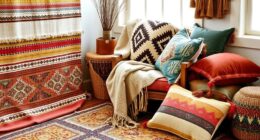To remove odors from furniture fabric, start by vacuuming thoroughly. Then, sprinkle baking soda on the fabric and let it sit for at least 20 minutes before vacuuming it up. You can also mix equal parts water and distilled white vinegar in a spray bottle, lightly mist the fabric, and allow it to dry. For a fragrant touch, use essential oils in a water spray. If odors persist, consider enzyme-based cleaners or activated charcoal to absorb smells. Each method has its advantages, and exploring them will help you find the best solution for your needs.
Key Takeaways
- Vacuum furniture thoroughly to remove loose dirt and organic matter before applying any odor removal techniques.
- Sprinkle baking soda on the fabric, let it sit for several hours, then vacuum to absorb odors.
- Mix equal parts water and distilled white vinegar, lightly spray the solution on the fabric, and let it air dry.
- Use enzyme-based cleaners to break down organic stains and odors effectively while being eco-friendly.
- Consider professional cleaning services for deep cleaning and specialized odor removal, especially for persistent smells.
Identifying Odor Causes
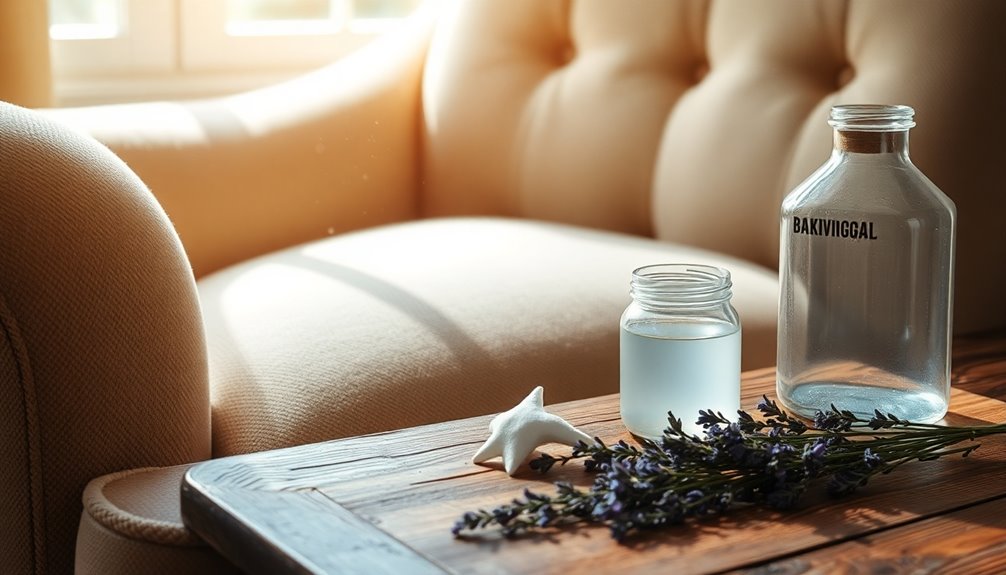
Identifying the causes of odors in furniture fabric is crucial for effective removal. You'll want to start by checking for organic matter and biological growth. Accidental food spills can create a breeding ground for bacteria and mold if you don't clean them promptly. If you have pets, be on the lookout for accidents involving urine or vomit, as these can introduce strong, lingering odors. Don't forget about sweat and body oils that accumulate over time, leading to musty smells.
Environmental factors also play a significant role. High humidity levels can foster mold growth, especially in damp areas. Poor ventilation traps odors, while smoking indoors leaves tobacco particles embedded in fabrics. Additionally, moisture can accumulate from spills or inadequate airflow, contributing to unwanted smells. Controlling humidity is essential to prevent these conditions from worsening.
Finally, consider chemical sources. Cleaning products can leave behind strong scents, and new furniture often emits volatile organic compounds (VOCs). Aging materials, like leather, can produce musty odors, while invisible stains from kids or pets can linger unnoticed. By identifying these causes, you can develop a targeted plan to tackle the odors effectively.
Using Baking Soda
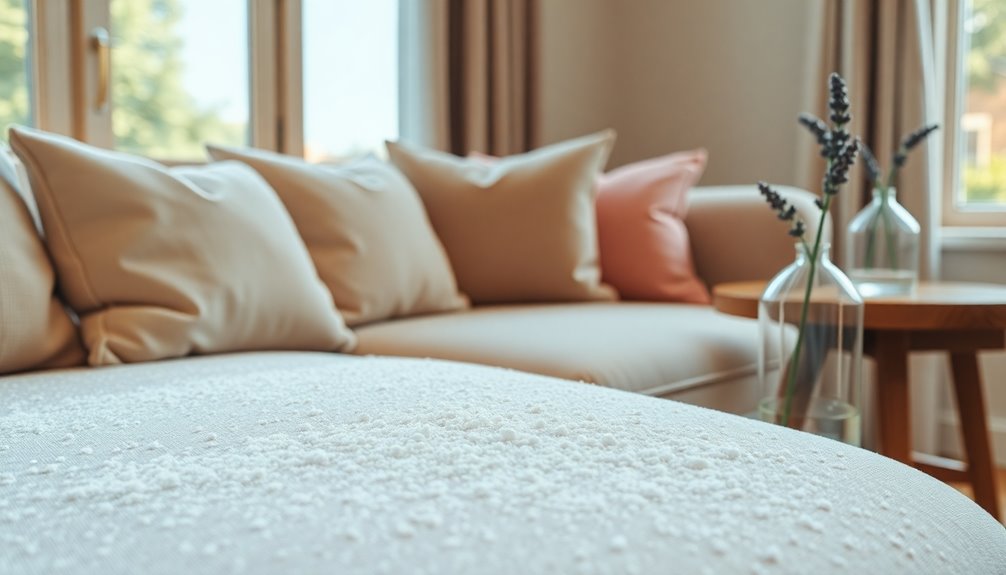
Baking soda is a powerful ally when it comes to eliminating odors from furniture fabric. Start by vacuuming the furniture thoroughly to remove any dirt, dust, and debris. If possible, take off the cushions to ensure a deep clean. Next, sprinkle a generous layer of baking soda evenly over the entire surface of the furniture, including cushions and areas that see a lot of use. Use a soft-bristled brush to gently work the baking soda into the fabric, paying special attention to seams and corners where odors tend to linger.
Let the baking soda sit for 20 minutes to an hour, or even overnight for stronger smells. This allows it to absorb moisture and neutralize odor-causing substances effectively. When you're ready, vacuum up the baking soda using an upholstery attachment, making sure to get into all the crevices and seams to remove every trace. It's important to note that baking soda is a cost-effective solution compared to commercial cleaning products. Once you've finished, replace any cushions you removed. If any odors persist, don't hesitate to repeat the process for optimal results. Baking soda is a natural, safe solution that can make your furniture smell fresh again!
Utilizing Vinegar
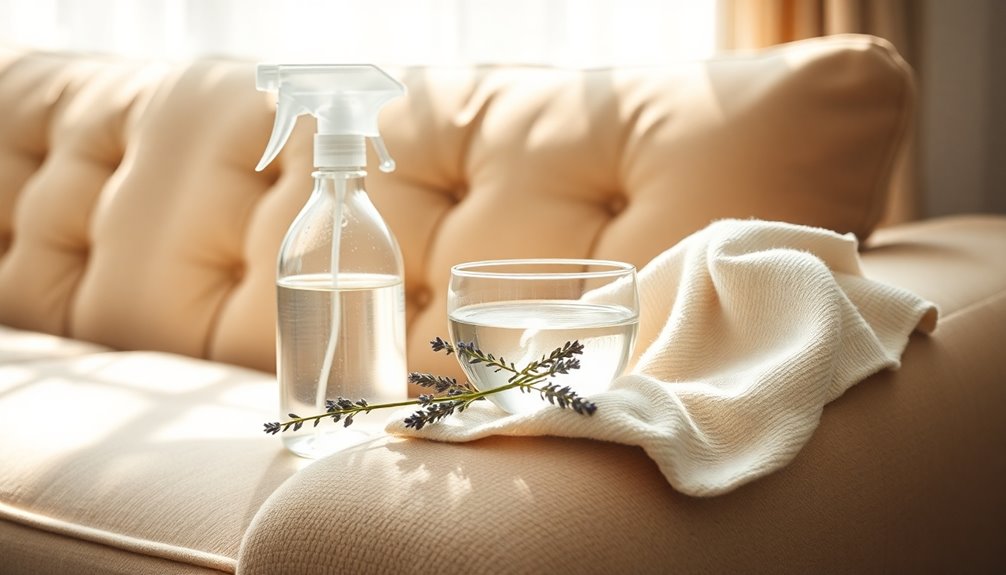
Vinegar is an excellent option for tackling stubborn odors in furniture fabric. To prepare your vinegar solution, mix 4 parts water with 1 part distilled white vinegar in a spray bottle. For a more concentrated approach, consider equal parts of water and white vinegar. Just be sure to use pure white vinegar, not white wine vinegar, as this helps prevent damage to your fabric.
When applying the vinegar solution, lightly spray it over the furniture while keeping the spray bottle about a foot away. This way, you’ll avoid oversaturation. For stubborn stains, apply the solution directly to the stain and gently rub it in. Let it sit for about 10 minutes before wiping it down with a damp cloth. If odors linger, don’t hesitate to repeat the process. Additionally, it’s important to act quickly for recent stains to prevent them from setting in. After wiping down the area, ensure that the furniture is well-ventilated to aid in drying and further odor removal. If you’re still facing issues, consider a commercial fabric cleaner specifically designed for upholstery, as this can be effective in removing stains from your sofa. Regular maintenance and immediate action on spills can significantly enhance the longevity and appearance of your furniture.
For specific odors, like urine or smoke, focus the solution directly on those areas. After application, allow the surface to air dry completely. Always test the solution on a hidden spot first to ensure it won't harm the fabric. The strong vinegar smell will fade as it dries, leaving your furniture fresh and odor-free.
Applying Essential Oils
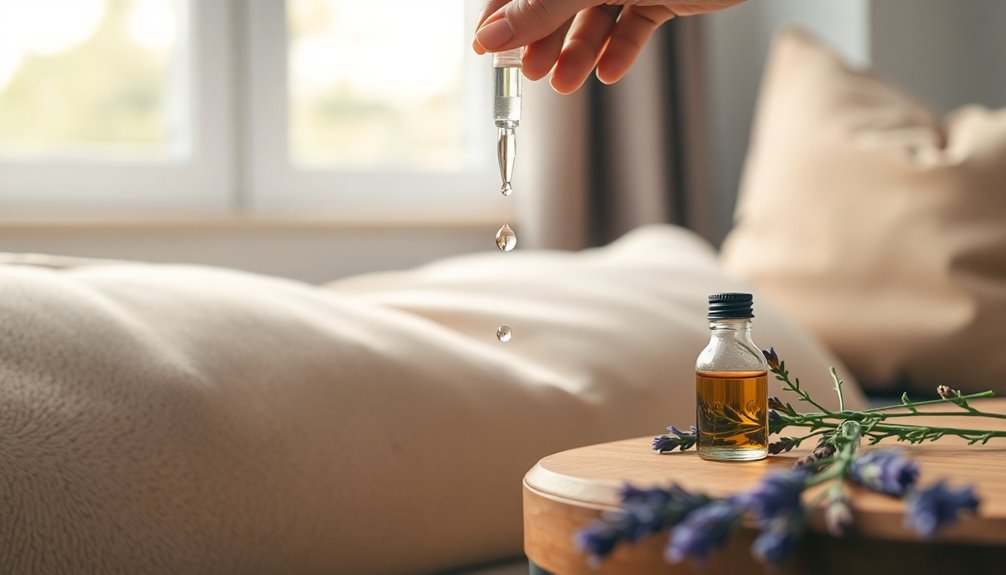
Transform your furniture's scent by applying essential oils, a natural and effective method for odor removal. Start by preparing your essential oil solution. Mix about 3 oz of water with 20 drops of your chosen essential oil in a spray bottle. Oils like lavender, lemon, and eucalyptus are great for neutralizing odors. Feel free to experiment with different combinations to find your perfect scent.
When you're ready to apply the solution, lightly spray it onto the fabric—avoid saturating it. It's a good idea to test a small, inconspicuous area first to ensure the fabric won't be damaged or discolored. You can treat upholstery, curtains, and other fabric surfaces as needed. After spraying, let the fabric air dry completely without using heat. If the odor lingers, you may want to repeat the application. Additionally, using natural methods for odor removal can help maintain a healthy living environment.
For ongoing freshness, consider using essential oil-infused sprays regularly between deep cleans. You can also enhance effectiveness by combining essential oils with other odor-fighting methods. Always shake your solution well before use, and store it in a cool, dark place to preserve its potency.
Employing Natural Methods
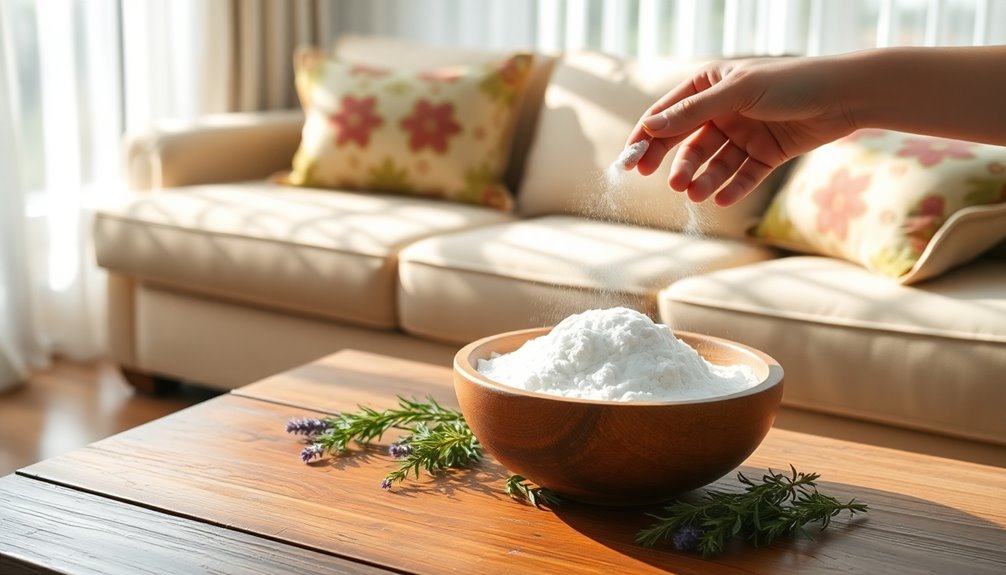
Exploring natural methods can be a game changer when it comes to removing odors from furniture fabric. One of the simplest solutions is baking soda. Just sprinkle it generously over the smelly area and let it sit for several hours or overnight. This allows it to absorb the odor effectively. The next day, vacuum up the baking soda, and your furniture should smell fresher. For an added touch, mix baking soda with a few drops of essential oils before application.
Another effective option is vinegar. Combine equal parts of water and white vinegar in a spray bottle, lightly mist the affected area, and let it air dry. Vinegar not only deodorizes but also has antibacterial properties. For tougher odors, let the solution sit for about 10 minutes before wiping it down. Additionally, maintaining proper ventilation can help prevent odor buildup in your furniture fabric.
Lastly, consider hydrogen peroxide. Mix it with water in a spray bottle, apply it to the affected area, and allow it to sit for a few minutes before wiping it off. Always test any solution on a hidden spot first to avoid damage. These natural methods can help keep your furniture smelling fresh and inviting!
Activated Charcoal Benefits
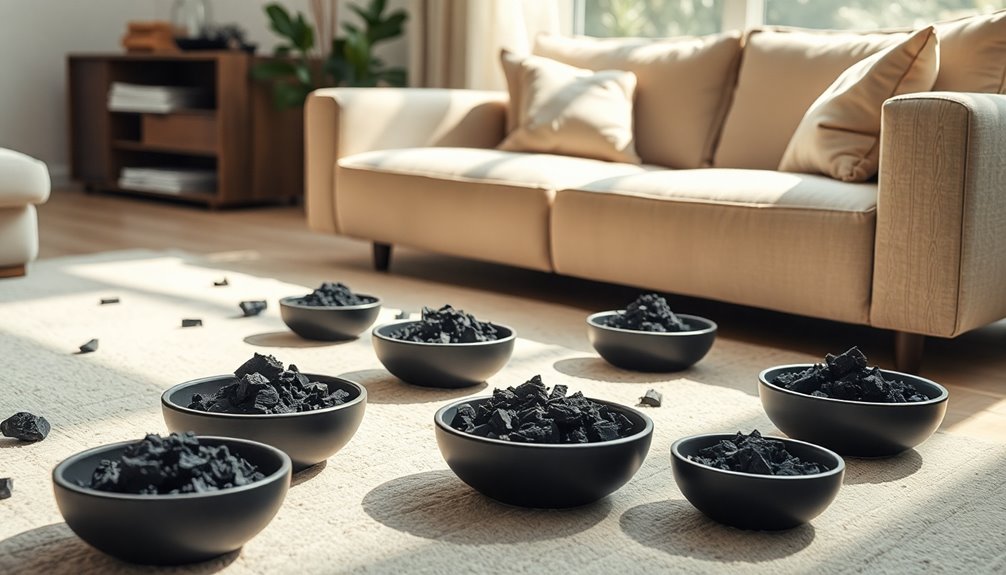
When it comes to removing odors from furniture fabric, activated charcoal offers impressive benefits that you won't want to overlook. With a surface area equivalent to about a football field per teaspoon, it effectively adsorbs unpleasant smells instead of merely masking them. This permanent odor elimination occurs through the attraction of negatively charged contaminant ions to the positively charged charcoal, making it a powerful solution for lingering odors without damaging your furniture. Additionally, activated charcoal is known for its ability to reduce gas production within the body, which can also help in controlling odors in the home environment.
To use activated charcoal, you can place bags in the corners of your sofa cushions or strategically in areas where odors are strongest. It's best to avoid direct contact with fabric to prevent staining. For enhanced results, consider combining charcoal with sodium bicarbonate, leveraging both for superior odor control.
Activated charcoal isn't just for furniture; it also purifies air, removes smoke particles, and tackles pet dander. It's a non-toxic option, making it safe around pets and children. Plus, periodic replacement of charcoal bags ensures they maintain their effectiveness. Overall, activated charcoal stands out as a versatile, practical, and cost-effective solution for eliminating odors in your home.
Enzyme-Based Cleaners
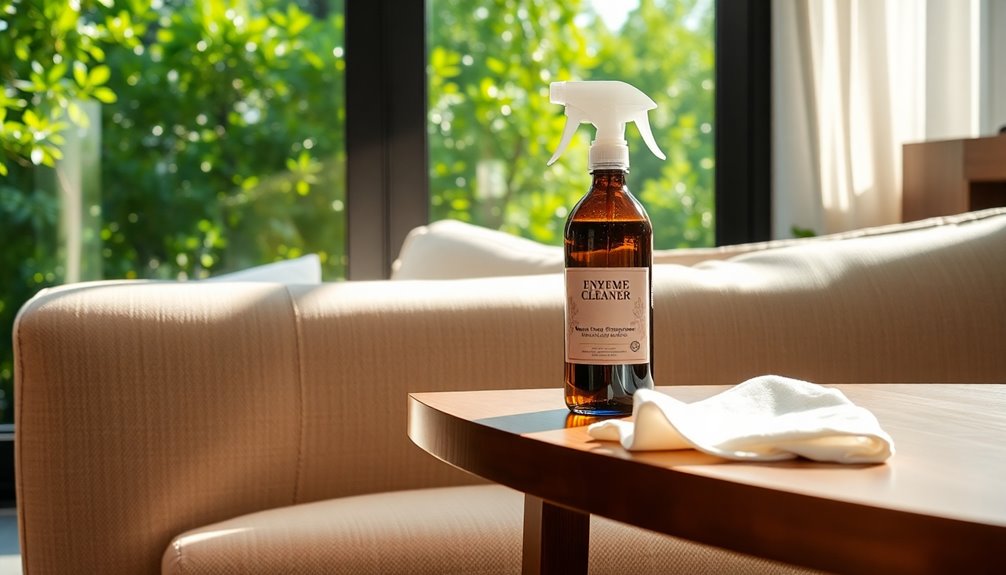
While activated charcoal is a fantastic option for tackling odors, enzyme-based cleaners provide another powerful solution for freshening up your furniture fabric. These cleaners use biological molecules called enzymes, which act as catalysts to break down dirt, grease, and organic materials that cause unpleasant smells. Research has shown that turmeric's anti-inflammatory properties can also aid in maintaining the freshness of fabrics by reducing odor-causing bacteria.
Different types of enzymes target specific stains: proteases tackle protein-based stains like blood and sweat, amylases focus on starchy residues, lipases handle greasy spots, and cellulases improve fabric softness while removing dirt. Enzyme cleaners are non-toxic, biodegradable, and eco-friendly, making them a safe choice for your home. Additionally, the ENZYME Bio-Enzymatic Cleaner / Odor Eliminator is designed to effectively remove organic stains from various surfaces.
To use enzyme cleaners effectively, start by removing excess liquid and vacuuming the area. Always test the fabric's color stability first to prevent damage. After spraying the enzyme cleaner on the affected area, let it sit for 10-15 minutes, allowing the enzymes time to work their magic. Follow up by cleaning the surface as usual to eliminate any leftover cleaner.
These products are versatile and work well on various surfaces, including upholstery, carpets, and even pet beds. With enzyme-based cleaners, you can effectively combat stubborn odors and stains without harsh chemicals.
Hydrogen Peroxide Usage
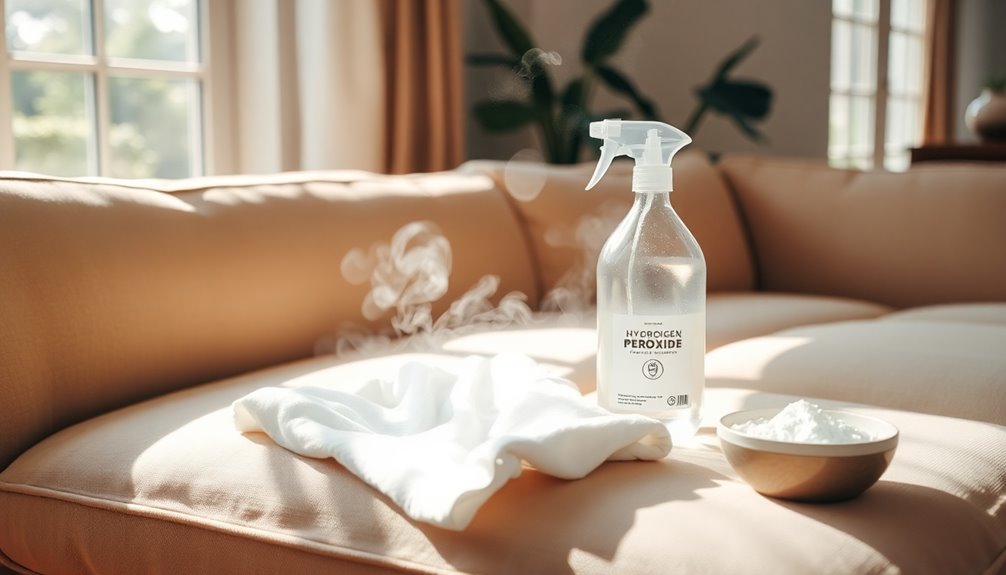
Hydrogen peroxide is a powerful and versatile cleaner that can effectively remove odors from furniture fabric. For best results, use a 3% solution, as higher concentrations might damage or discolor your fabric. Always check the care label to ensure your furniture can handle hydrogen peroxide, and pretest it on an inconspicuous area to confirm colorfastness.
To apply, lightly spray the fabric with the hydrogen peroxide solution, ensuring it's just saturated, not soaked. Let it sit for 15-20 minutes to absorb. For enhanced odor removal, consider mixing hydrogen peroxide with dish soap and baking soda. However, avoid over-saturation, as this can prolong drying times and potentially harm the fabric. Additionally, it's important to remember that cleaning effectiveness can vary based on the specific fabric used.
After the dwell time, rinse the area with water and use a shop vac or let it air dry. Remember that you may need multiple applications for stubborn odors. Ensure good ventilation during use to avoid inhaling fumes, and be mindful that certain fibers like silk or wool may not be compatible with hydrogen peroxide. If in doubt, opting for commercial fabric cleaners might be your best bet.
Professional Cleaning Options
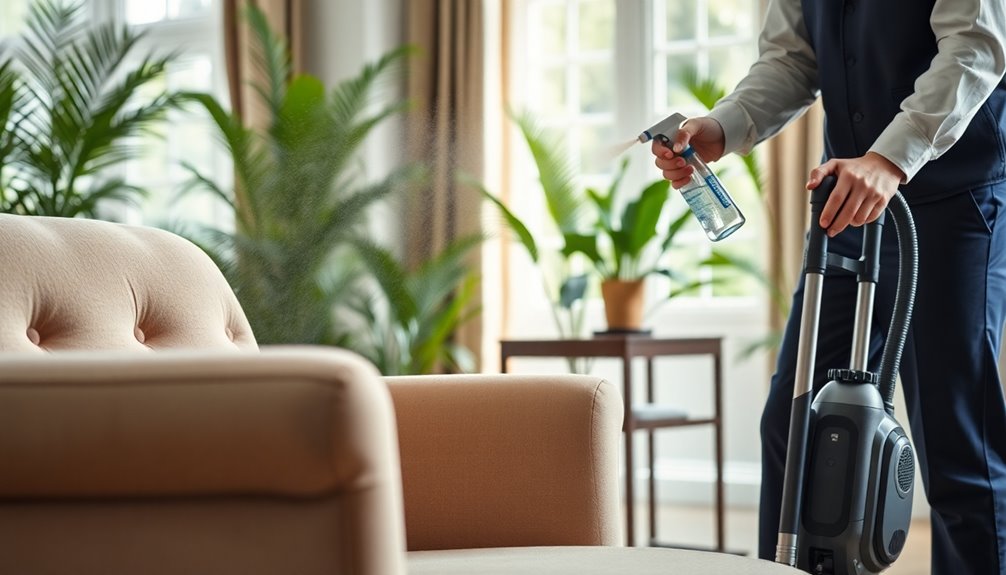
If DIY methods like hydrogen peroxide haven't fully tackled the odors in your furniture fabric, professional cleaning options can provide a more thorough solution. Professional cleaners bring expertise and specialized equipment designed to deep clean various fabric types effectively. They customize their approach based on the specific odor source, ensuring that the cleaning process is both effective and safe for your upholstery. Additionally, their services contribute to improved indoor air quality, which is essential for a healthier living environment. Air purifiers can also complement the cleaning process by continuously removing airborne pollutants.
Looking for certified professionals, like those from the Institute of Inspection, Cleaning and Restoration Certification (IICRC), guarantees high standards. Many of these cleaners specialize in upholstery and use pet- and child-friendly products, making them a safe choice for your home.
In addition to deep cleaning, they often employ enzyme-based cleaners that target and break down the odor's source. You'll also benefit from their knowledge of proper ventilation and drying techniques, which help prevent moisture-related odors from returning.
Hiring professionals saves you time and effort while ensuring a hygienic environment by removing allergens and bacteria. With the right service, you can enjoy long-lasting freshness and protection for your furniture fabric, making it a worthwhile investment.
Chemical Solutions to Consider
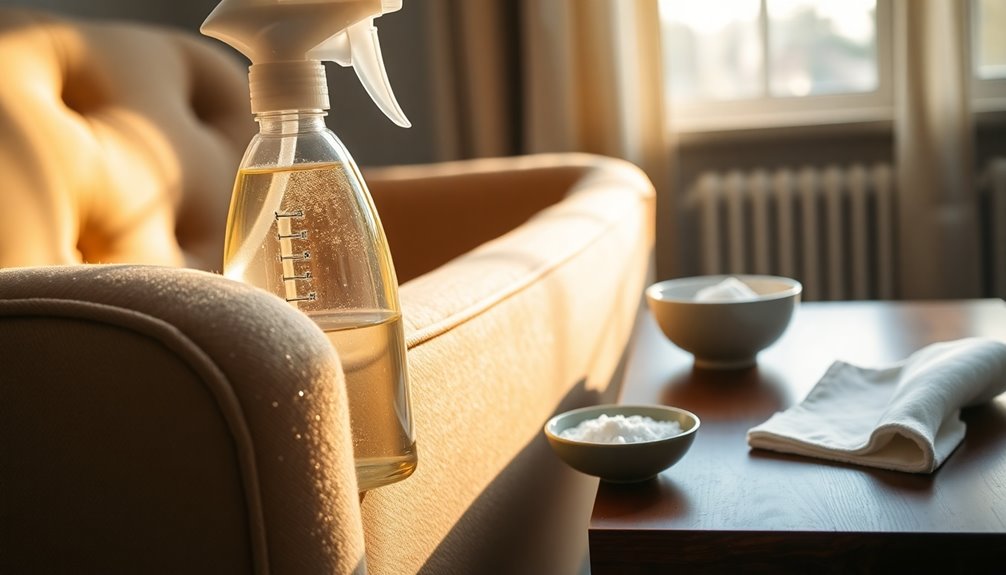
When it comes to tackling stubborn odors in furniture fabric, chemical solutions can be highly effective. Industrial-strength odor eliminators, like State Fabric & Textile Refresher, break down odor molecules on contact, targeting the source instead of just masking the smell. If you prefer something eco-friendly, Kontrol SE offers sustainable odor-neutralizing technology that's safe for the environment, effective on various materials, and helps prevent odors from becoming trapped over time. Odor management is essential for maintaining cleanliness and comfort, ensuring that your living or working space remains inviting.
You might also consider chemical odor remover sprays, especially if you have pets. These sprays come in gel, spray, or powder forms and are designed to eliminate odors without strong fragrances. Look for kid and pet-friendly options that neutralize odors at their source.
For a more natural approach, enzyme-based cleaners can be your go-to. They effectively break down organic stains and target specific odors, like pet accidents, without harsh chemicals.
Lastly, while biocide cleaners can remove mildew smells, they may damage furniture, so use them cautiously. Sealants can trap odors in wooden furniture, preventing them from spreading, but ensure you choose the right option for your specific needs.
Frequently Asked Questions
How Often Should I Clean My Furniture Fabric to Prevent Odors?
To keep your furniture fabric fresh and odor-free, you should deep clean it at least once or twice a year. If you've got kids or pets, aim for every three to four months. Regular maintenance is key; vacuum weekly and treat stains immediately. Fluffing fabric fibers with a dry brush helps too. Don't forget to air out your furniture in well-ventilated areas to prevent odors from settling in.
Can Odors Return After Treatment, and How Can I Prevent It?
Yes, odors can return after treatment due to factors like trapped particles, moisture, and high humidity. To prevent this, regularly use odor-neutralizing products and ensure good airflow in your space. You can also employ dehumidifiers to reduce moisture levels. Periodic cleaning and vacuuming, along with using baking soda and vinegar solutions, will help maintain freshness. Lastly, be mindful of spills and consider furniture materials with low VOCs to minimize future odors.
Are There Specific Fabrics That Resist Odors Better Than Others?
Yes, there are specific fabrics that resist odors better than others. Crypton fabrics are your best bet, as they repel odors and bacteria while being easy to clean. Sustain performance fabrics are also durable and cleanable without harsh chemicals. Revolution fabrics, made from upcycled materials, offer durability and stain resistance. Microfiber works well too, as it prevents spills from soaking in, reducing odor absorption. Choose wisely, and you'll enjoy fresher furniture!
What Should I Do if the Odor Persists After Cleaning?
If the odor persists after cleaning, don't worry, there are still options. First, try applying baking soda again and let it sit for a few days to absorb the smell. You can also spray a vinegar and water solution to neutralize any remaining odors. If that doesn't work, consider using commercial fabric fresheners or even professional cleaning services to tackle stubborn smells. Regular maintenance can help prevent odors from returning in the future.
Is It Safe to Use Odor Removal Methods on All Types of Furniture?
It's not always safe to use odor removal methods on all types of furniture. Different fabrics require specific care; for instance, suede and delicate materials need gentle treatments to avoid damage. Always test any product on a small, hidden area first. If you're unsure, stick to eco-friendly options or consult the manufacturer's guidelines to prevent any adverse reactions. Taking these precautions helps ensure your furniture stays in great condition while eliminating odors.
Conclusion
In conclusion, tackling odors in furniture fabric can be simple and effective with the right methods. Start by identifying the cause of the smell and try solutions like baking soda, vinegar, or essential oils. For tougher odors, consider enzyme-based cleaners or hydrogen peroxide. If all else fails, don't hesitate to reach out to professionals for help. With a little effort and the right approach, you can restore your furniture's freshness and enjoy your space again.
